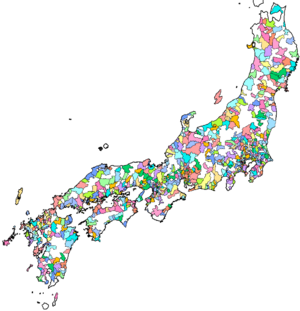Cities of Japan facts for kids
In Japan, a city (called shi in Japanese) is a type of local area that helps manage public services. Cities are similar to towns (machi) and villages (mura), but they are not part of larger areas called districts (gun). The rules for what makes a city were set by a law called the Local Autonomy Law in 1947.
Contents
What Makes a Place a City?
To become a city in Japan, a place needs to meet certain requirements. These rules help make sure that cities are truly urban areas with enough people and services.
Here are the main conditions:
- Population: A place usually needs to have at least 50,000 people living there.
- Urban Homes: More than 60% of the homes must be in the main urban part of the area.
- Urban Jobs: More than 60% of the people must work in jobs like business, industry, or other city-based jobs.
- Local Rules: The area must also meet any other special rules set by its local prefecture.
Once these conditions are met, the governor of the prefecture and the Minister for Internal Affairs and Communications must approve the change.
Sometimes, a city might have fewer than 50,000 people. For example, Utashinai, Hokkaido is a city with only about 3,000 people. This is because once a place becomes a city, it usually stays a city, even if its population drops.
Becoming a City Through Mergers
To help smaller towns and villages combine and save money on administration, Japan has a special rule. If towns or villages merge together, they can become a city with a population of just 30,000 people, instead of the usual 50,000. This rule has helped many areas become cities.
Special Kinds of Cities
Some very large cities in Japan have extra powers. The government can give these cities special titles based on their size.
Core Cities and Designated Cities
Cities with at least 200,000 people can be called a core city or a designated city. These special titles mean that the city government gets more power to manage its own affairs. They can handle more services directly, instead of the prefectural government doing it.
Tokyo's Unique Status
Tokyo, the capital of Japan, is very special. It used to be a city, but since 1943, it's been called a metropolis (to). This means it's like a special kind of prefecture.
The main part of Tokyo is made up of 23 special wards. Each of these wards acts almost like its own city. Tokyo also includes other regular cities, towns, and villages within its larger area.
How Cities Started in Japan
Cities in Japan have a long history. They were officially introduced in 1888 during a time called the "Great Meiji mergers." Before this, major urban areas were known as "urban districts."
In 1889, there were 39 cities across Japan. Over time, this number grew a lot. By 1945, there were 205 cities. After World War II, during the "great Shōwa mergers" in the 1950s, the number of cities almost doubled again.
Today, there are 792 cities in Japan (as of October 1, 2018). This shows how much Japan has grown and changed over the years.
See also
 In Spanish: Ciudades de Japón para niños
In Spanish: Ciudades de Japón para niños


